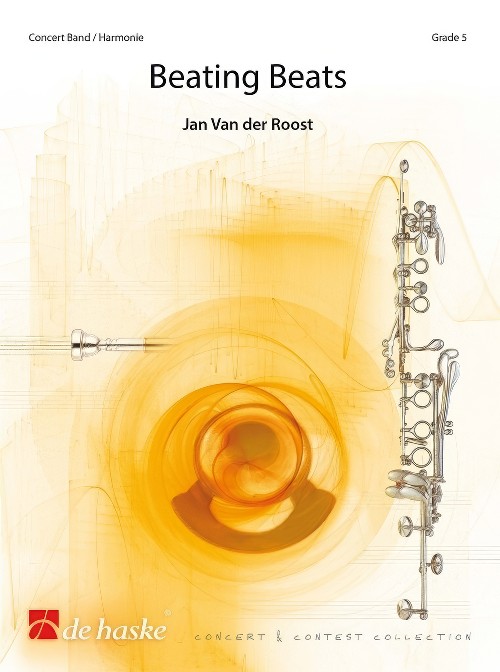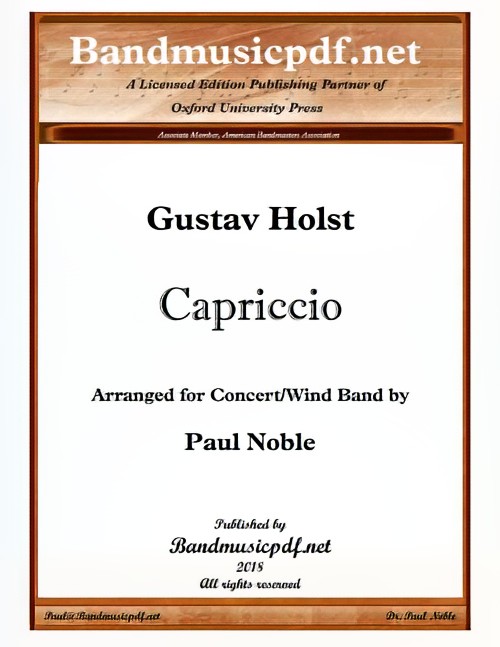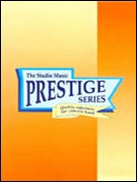Results
-
£15.95
A Psalm of Praise - Score only - James Curnow
Program NotesOriginally conceived as a brass band tone poem, A Psalm of Praise gained huge popularity when it was first published in 1980. When it first appeared in print, the work was widely performed by Salvation Army bands around the world. It is full of interest and presents plenty of what for many bands will be realistically achievable levels of musical and technical challenge.As with much Salvation Army music, it was inspired by words from scripture, specifically from Psalm 100. Musically, it is based on the well-known hymn tune Praise My Soul the King of Heaven, with motifs and fragments of the tune appearing throughout the work in various guises alongside the original thematic material.James Curnow's skillfully economic use of melodic and rhythmic ideas is demonstrated to perfection in this work, which will be rewarding to rehearse in detail and perform and will provide a useful addition to concert repertoire.
Estimated dispatch 7-14 working days
-
 £72.00
£72.00"Our Own Red, White and Blue" - Henry Fillmore
This catchy little tune from march composer Henry Fillmore is one that you will be humming over and over again. Though one of his lesser known titles, it is unique for Fillmore marches as it is very playable compared to most of his barn burning marches and it does not contain the usual modulation or trio. This accessible march is sure to be a favorite for your band.
Estimated dispatch 12-14 working days
-
 £99.95
£99.95Sinfonietta No.2 - A Sign of the Times (Concert Band - Score and Parts) - Wiffin, Rob
It was an interesting challenge to return to the form of a sinfonietta some twenty years after the last one. This work is not hugely problematic to play but was written without regard for technical demands, following a series of compositions that needed to take difficulty level into consideration. The work has five percussion parts but the tuned percussion, although desirable, can be omitted. As for the band parts, Oboe 2 is largely covered elsewhere but the colour of the cor anglais would be a definite enhancement to the overall sound. The work was written in 2025 when it seemed as if the world was a particularly volatile place.The first movement 'Foment' seeks to capture that menacing mood of unrest and the potential for violence that seemed to erupt without warning and without efforts to contain it from warmongers posing as peacemakers. The music is severe and focussed with just a short scherzo-like episode of levity to balance the quasi-military mood.'A Dream of Peace' takes a few moments to contemplate a different, more peaceful world and several ideas are considered before settling on the slow waltz-like melody. This uses a very tonal language but is given a particular hue by its use of sevenths and ninths and there are moments of stress which disrupt the tranquillity.In 'Call to Arms' the warlike mood returns with a sense of restless energy that drives the music to its conclusion.- Rob WiffinDuration: 14.00
Estimated dispatch 7-14 working days
-
 £126.50
£126.50Beating Beats (Concert Band - Score and Parts) - Van der Roost, Jan
Beating Beats rhythmically is a rather special piece: more conventional metres are manipulated in such a way that the listener (without score) may be confused and even misled at various points! The 'regular four beat accents in a 4/4 measure for example are often not adhered to, giving the impression of a different metre altogether. However, at the same time it may be that some instruments do follow this "normal" 4/4 metre, thus confusing everyone - performers and listeners alike! On one hand, it is a "simple" piece with very playable and melodic themes, but their mysterious rhythmic makes it not only sound more complicated, but also makes for a greater challenge for both players and the conductor! As is mostly the case with Jan Van der Roost's works, the orchestration is both colourful and contrasting, with every section of the modern wind orchestra used equally. All in all, it's a work full of surprises with some unexpected harmonies and special melodic lines but above all, with metrical and rhythmical sure to catch you unawares! Duration: 7.00
Estimated dispatch 7-14 working days
-
 £140.00
£140.00Capriccio (Concert Band - Score and Parts) - Holst, Gustav - Noble, Paul
The following notes have been excerpted by the arranger from those presented in the Introduction by Imogen Holst, daughter of Gustav Holst: Holst wrote this work in the spring of 1932, while he was guest Lecturer in Composition at Harvard University. He had been asked by Nathaniel Shilkret to write 'a short radio piece, not longer than five or six minutes.' for a composers' series on folk music themes. Holst wrote to me on 13 May 1932, saying: 'On May 1 I started sketching a piece for Shilkret's Radio jazz band in New York. I finished the sketch on the 4th and the full score on the 8th... Shilkret wanted something on American airs but I've left them out because I prefer my own so he may reject the thing.' Shilkret was enthusiastic about the piece, but he was unable to use it for his series. 'I hate to give it up,' he told the composer, 'but I cannot play it because it is not based on a definite English or American folk theme.' Holst never revised his hurriedly-written work, probably because he had too many other things to write during the remaining two years of his life, when he was having to spend a good deal of his time in hospital. The autograph manuscript of his original full score is in the British Library, MS Add.47833. The work had no name: Holst referred to it either as his 'Jazz band piece' or as 'Mr. Shilkret's Maggot.' The score needed editing. There were gaps and patches, with incomplete dynamics and phrase marks. I made the version for orchestra and named it 'Capriccio' in spite of the viola's (now saxophone's) expressive opening, because from the moment of the marimba's first animated remark there can be no doubt about the mood of the music. - Imogen Holst (1968)
Estimated dispatch 7-14 working days
-
 £551.99
£551.99Sinfonia Hungarica (Concert Band - Score and Parts) - Van der Roost, Jan
This three-movement symphony musically depicts the history of Hungary. Key historical figures, wars and other important events from this country inspired all three movements. The first movement depicts Atilla, the King of the Huns, and is characterised by fear, threat and aggression. The second movement focuses on Arpad, the founder of the Hungarian State and the final movement is named after Istvan, the King who introduced Christianity into Hungary. The beautiful theme of the national hymn appears throughout the symphony, however it is often partially hidden. It is used as a "thread," hardly recognizable at the beginning, becoming more and more obvious near the end and it concludes the symphony as the "final apotheosis," making the band sound like a majestic living organ.Duration: 12:45
Estimated dispatch 7-14 working days
-
 £184.95
£184.95PARTITA for Concert Band (Darrol Barry) (Prestige Concert Band - Score and Parts) - Barry, Darrol
This work is cast in four movements: Introit; Impromptu; Elegy (31.12.04); Finale. Grade 5. (Recorded on QPRM150D, CHIVALRY, Royal Northern College of Music Wind Orchestra) PARTITA FOR CONCERT BAND is cast in four movements: Introit - begins majestically with brass, saxes and percussion carrying the main theme from which most of the following ideas originate. It is repeated by the woodwinds and moves via a solo side drum into the piu mosso. New ideas are introduced by trombones, the horns and euphoniums leading to the central idea played by oboe. This leads, in turn, via full band to the closing movement. 2. Impromptu -once again the opening theme is the basis of the whole movement, using most of the composer's tricks, augmentation, retrograde, inversion and fugato, it moves along in a very confident style. A muted solo trumpet links into the third movement. Elegy (26/12/04) - this movement was prompted by the devastating events of Boxing Day 2004, the Asian Tsunami. The movement opens bleakly until a solo flute gives us the main theme over a troubled accompaniment. The opening mood returns but timpani and tam-tam herald return of the main theme for the full band. The opening theme is heard again as the music subsides but never settles. Finale - this spirited 6/8 vivo opens up with percussion and horns and trumpets announce the main idea, punctuated with short chords from the lower band. A new four bar theme is heard over a bass tread, the theme overlaps itself and quavers swirl up and down the band. Material from the first movement is heard transformed by the energy of the finale and the music surges towards a sudden close. Performance time: 15:35
Estimated dispatch 7-14 working days
-
 £44.95
£44.95PARTITA for Concert Band (Darrol Barry) (Prestige Concert Band - Score only) - Barry, Darrol
This work is cast in four movements: Introit; Impromptu; Elegy (31.12.04); Finale. Grade 5. (Recorded on QPRM150D, CHIVALRY, Royal Northern College of Music Wind Orchestra) PARTITA FOR CONCERT BAND is cast in four movements: Introit - begins majestically with brass, saxes and percussion carrying the main theme from which most of the following ideas originate. It is repeated by the woodwinds and moves via a solo side drum into the piu mosso. New ideas are introduced by trombones, the horns and euphoniums leading to the central idea played by oboe. This leads, in turn, via full band to the closing movement. 2. Impromptu -once again the opening theme is the basis of the whole movement, using most of the composer's tricks, augmentation, retrograde, inversion and fugato, it moves along in a very confident style. A muted solo trumpet links into the third movement. Elegy (26/12/04) - this movement was prompted by the devastating events of Boxing Day 2004, the Asian Tsunami. The movement opens bleakly until a solo flute gives us the main theme over a troubled accompaniment. The opening mood returns but timpani and tam-tam herald return of the main theme for the full band. The opening theme is heard again as the music subsides but never settles. Finale - this spirited 6/8 vivo opens up with percussion and horns and trumpets announce the main idea, punctuated with short chords from the lower band. A new four bar theme is heard over a bass tread, the theme overlaps itself and quavers swirl up and down the band. Material from the first movement is heard transformed by the energy of the finale and the music surges towards a sudden close. Performance time: 15:35
Estimated dispatch 7-14 working days
-
 £244.00
£244.00Anemoia - Gauthier Dupertuis
Gauthier Dupertuis wrote Anemoia as part of his master's thesis at the Lausanne University of Music. It is dedicated to the most significant figure in his musical life: his teacher Jean-Claude Kolly.Anemoia is the name given to the feeling of nostalgia that one feels for a time that has never known. This emotion often translates into the uneasy sensation of having lost something important or of not living at the right place or time. Fascinated by this concept, Gauthier Dupertuis tried to translate it into music oscillating between exaltation, anguish and nostalgia.The piece is formed by two movements: (Un)desired sorrow and Behind the glass of time. The first movement initially evokes the feeling of unease one feels when suddenly struck by anemoia. It then evolves into majestic atmospheres, marking our admiration for times gone by. The second movement treats anemoia in a more melancholic way.The premiere took place on 6th December 2024, during Jean-Claude Kolly's last concert as a conductor of the Concordia de Fribourg, marking thirty years spent conducting this wind orchestra.
Estimated dispatch 7-14 working days
-
 £145.50
£145.50La banda de los guajiros - Sverre Indris Joner
Guajira is both a term for a song form, where most people will recognize the song "Guajira Guantanamera," but also a Cuban word for farmer or fieldworker, as there are many of in the eastern Oriente province of Cuba where this rhythm originated. "La Banda de los guajiros" translates directly to "The Guajira Band."It is composed for wind orchestra by Sverre Indris Joner, who already in 1985 traveled to Cuba to learn the secrets of Caribbean music. The rhythms used in this piece are thoroughly explained in the textbook "Latinmusikkens ABC," which is also published by Noteservice/Norsk Musikkforlag.The piece uses traditional elements from Cuban music such as Guajira, Son Montuno, and Danzn, all falling under the genre of salsa.It is recommended that both conductor and percussionists familiarize themselves with the execution of the different rhythm patterns. Instruments like congas and timbales particularly have a range of different rhythm patterns. The role of the guiro instrument cannot be underestimated. Despite its seemingly simple content, it is the glue that holds everything together!
Estimated dispatch 7-14 working days
